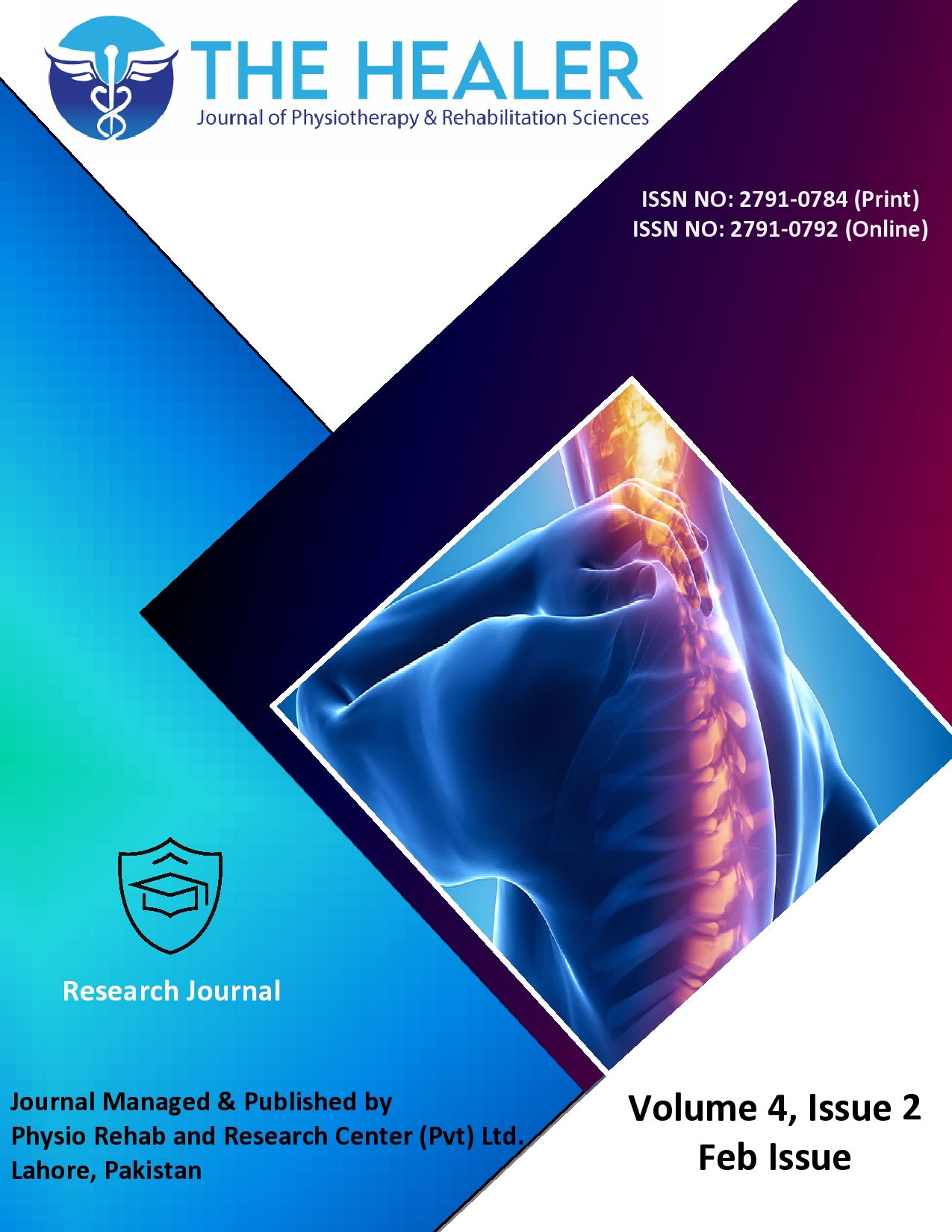Association of Carpal Tunnel Syndrome with Body Mass Index among University Students
Carpal Tunnel Syndrome & BMI among Females
DOI:
https://doi.org/10.55735/hjprs.v4i2.198Keywords:
body mass index, carpal tunnel syndrome, studentsAbstract
Background: Carpal tunnel syndrome is caused due to the compression of the median nerve in the carpal tunnel1, it is one of the most prevalent upper extremity neuropathies. Individuals with this syndrome commonly complain of pain, paraesthesia, altered sensory perception, and hand and wrist weakness, which impairs daily activities and diminishes physical function. Objective: Evaluate the association of carpal tunnel syndrome with body mass index among university students. Method: An analytical cross-sectional study was conducted on female students of the University of Lahore and the University of Gujrat. Students were selected with different BMIs and ages between 18 to 30 years while data were collected by using a standardized questionnaire and by performing the Phalen test whereas BMI was checked by using weight in kilograms divided by height in meter square. However students with a history of hand trauma, radius/ulna or wrist fracture or injuries in last 3 months and those who had comorbidities previously undergone surgery to the shoulder inflammatory arthritis in last 3 months and congenital deformities were excluded.Ethical approval was taken from Institutional Review Board (IRB) of The University of Lahore, Punjab, Pakistan. A consent was taken from the participants before collecting data. Ensured that data would be used for only research purpose. The research project was approved by research and ethical committee of University of Lahore. Data were collected from females of university of Lahore and university of gujrat and by evaluating the carpal tunnel syndrome in university females by phalens test and boston questionnaire. For descriptive analysis, mean and standard deviation were calculated for quantitative variables whereas frequencies and percentages were calculated for qualitative variables. For inferential statistics, a chi-square test was applied. Results: The study's results show that mean age of participants (years) is 22.30±2.04, body mass index of participants (kg/m²) is 20.36±2.63. Conclusion: It is concluded that there is no association between body mass index classes with p-value. As p-value shown in the results was 0.389. Therefore, both have no effects on each other, while body mass index and Phalen's test have very weak positive co-relation with each other with p-value of 0.045.
References
Somaiah A, Roy A. Carpal tunnel syndrome. Ulster Med J 2008; 77(1): 6-17.
Jiménez-del-Barrio S, Cadellans-Arróniz A, Ceballos-Laita L, et al. The effectiveness of manual therapy on pain, physical function, and nerve conduction studies in carpal tunnel syndrome patients: a systematic review and meta-analysis. International Orthopaedics 2022; 46(2): 301-12.
Vögelin E, Mészàros T, Schöni F, Constantinescu MA. Sonographic wrist measurements and detection of anatomical features in carpal tunnel syndrome. The scientific World journal 2014; 2014.
Bekele A, Abebe G, Hailu T, et al. Prevalence and Associated Factors of Carpal Tunnel Syndrome Among Diabetic Patients in Arba Minch General Hospital, South West Ethiopia, 2021. Diabetes, Metabolic Syndrome and Obesity: Targets and Therapy 2022: 983-93.
Zaralieva A, Georgiev GP, Karabinov V, Iliev A, Aleksiev A. Physical therapy and rehabilitation approaches in patients with carpal tunnel syndrome. Cureus 2020; 12(3).
Shetye V, Hamid A. Estimating prevalence of carpal tunnel syndrome and severity using boston carpal tunnel syndrome questionnaire among dexterous population. Pakistan Journal of Rehabilitation 2023; 12(1).
Al Shahrani ES, Al Shehri NA. Association between smartphone use and carpal tunnel syndrome: A case-control study. Journal of Family Medicine and Primary Care 2021; 10(8): 2816.
Gölen MK, OKUYAN DY. Are body mass index and the systemic immune-inflammation index risk factors for carpal tunnel syndrome? The European Research Journal 2023; 9(3): 468-76.
SATIŞ S, ETHEMOĞLU Ö, ETHEMOĞLU KB. The Relationship Between Clinical, Physical, Electrophysiological, Functional Findings and Body Mass Index in Patients with Idiopathic Carpal Tunnel Syndrome. Genel Tıp Dergisi 2022; 32(6): 627-30.
Tonga F, Bahadir S. The factors associated with carpal tunnel syndrome severity. Turk Neurosurg 2022; 32(3): 392-7.
Pal A, De S, Sengupta P, Maity P, Dhara PC. Relationship between Body Mass Index and Musculoskeletal Disorders among Women Cultivators. LokLF;, oa tula [; k% ifjizs {;, oa eqnñs: 90.
Bland JD. The relationship of obesity, age, and carpal tunnel syndrome: more complex than was thought? Muscle & Nerve: Official Journal of the American Association of Electrodiagnostic Medicine 2005; 32(4): 527-32.
Mohammad WS. Work-related risk factors for Carpal Tunnel Syndrome among Majmaah University female touchscreen users. Pakistan Journal of Medical Sciences 2019; 35(5): 1221.
Azadvari M, Haghshomar M, Feijani FA, Abdolrazagh H, Razavi SZE, Tayebi O. Demographical, Anatomical, Disease-Related, and Occupational Risk Factors for Carpal Tunnel Syndrome. Archives of Neuroscience 2021; 8(4).
Musolin K, Ramsey JG, Wassell JT, Hard DL. Prevalence of carpal tunnel syndrome among employees at a poultry processing plant. Applied ergonomics 2014; 45(6): 1377-83.
Lampainen K, Shiri R, Auvinen J, Karppinen J, Ryhänen J, Hulkkonen S. Weight-Related and Personal Risk Factors of Carpal Tunnel Syndrome in the Northern Finland Birth Cohort 1966. Journal of clinical medicine 2022; 11(6): 1510.
Feng B, Chen K, Zhu X, et al. Prevalence and risk factors of self-reported wrist and hand symptoms and clinically confirmed carpal tunnel syndrome among office workers in China: a cross-sectional study. BMC Public Health 2021; 21(1): 1-10.

Downloads
Published
How to Cite
License
Copyright (c) 2024 The Healer Journal of Physiotherapy and Rehabilitation Sciences

This work is licensed under a Creative Commons Attribution 4.0 International License.
CC BY











